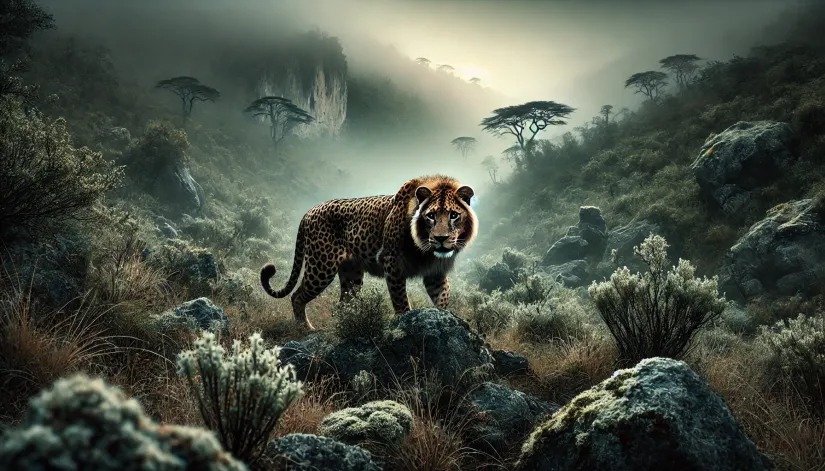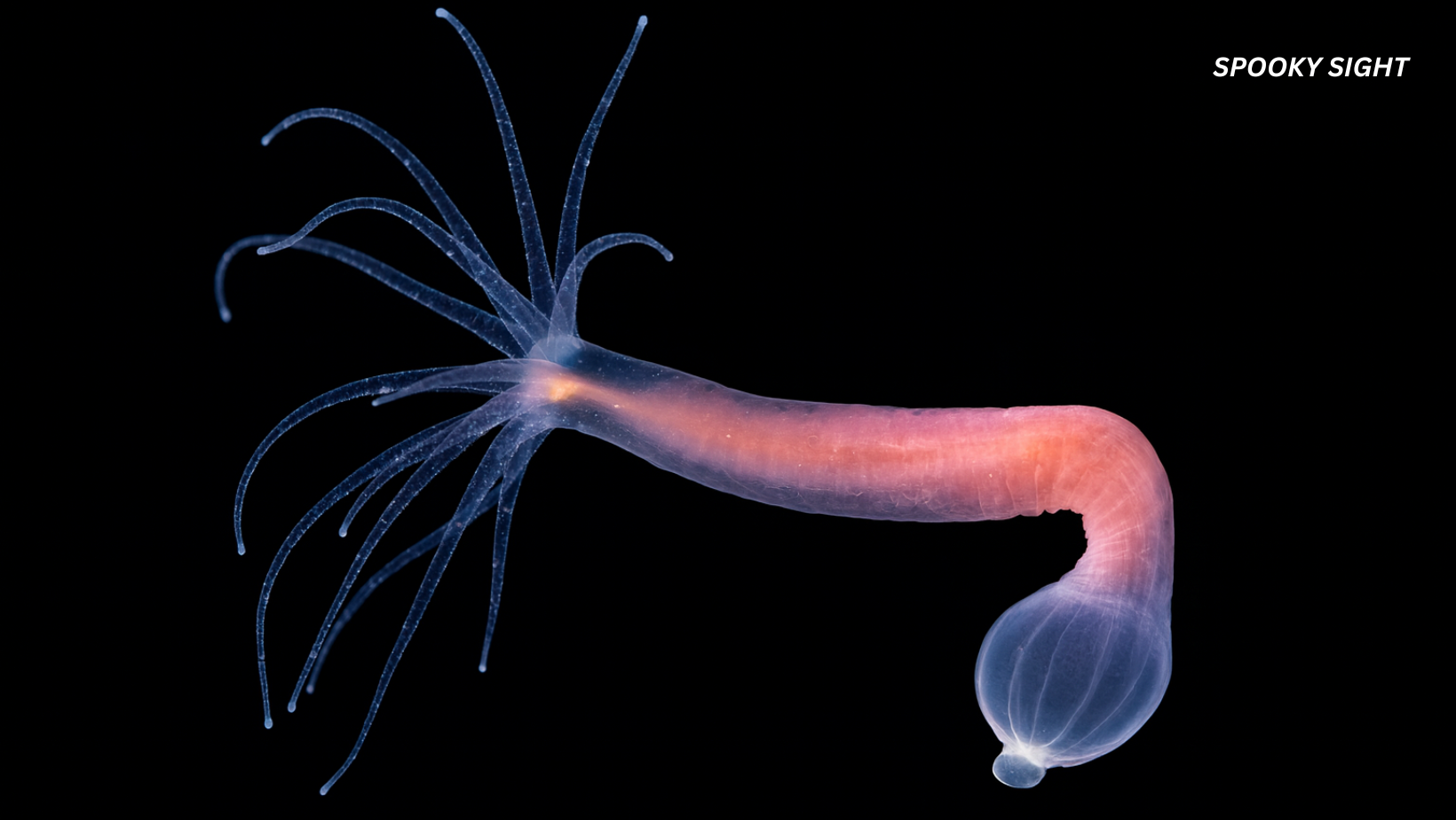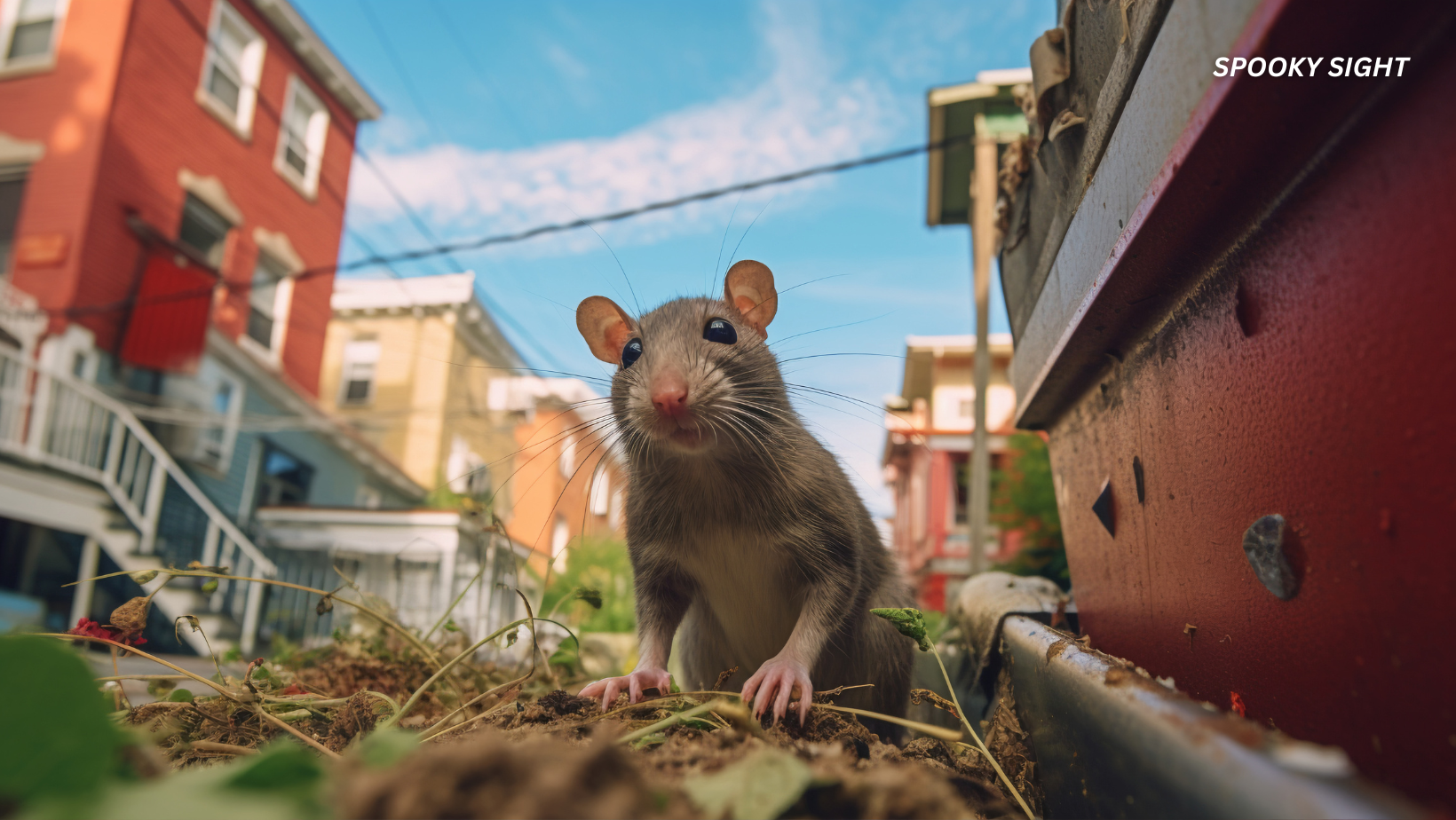The Marozi is a mysterious feline cryptid from the rugged mountains of Eastern Africa. Primarily spotted in Kenya during the early 20th century, this “spotted lion” has since almost entirely disappeared.
With no confirmed sightings in recent decades, some say the Marozi is just a myth. Others are convinced it’s real and offer intriguing theories about this evasive beast.
Which side are you on?
In this article:
Introduction to Marozi: The Mysterious Spotted Lion of Kenya
Definition and Overview
The Marozi (also known as the “spotted lion” or “spotted lion of Kenya”) is an African cryptid that has intrigued cryptozoologists and wildlife enthusiasts alike.
This evasive creature is described as a lion with distinctive leopard-like spots, which sets it apart from the typical African lion.
Unlike the usual lions (which lose their juvenile spots as they mature), this bizarre African cryptid retains its spots into adulthood—a strange feature that raised many questions among researchers.
The spotted lion of Kenya is generally smaller than a regular lion. He doesn’t have a mane (a characteristic more associated with lionesses or young lions).
However, the spots and its unique physical traits have led to various theories about its origins, including the possibility of it being a separate subspecies, a genetic mutation, or a hybrid between a lion and a leopard.
The cryptid’s name—derived from the local Kikuyu language—reflects its mysterious and solitary nature and translates to “solitary lion.”
Historical Background
Reports and sightings of the Marozi date back to the early 20th century, with the first known European encounter occurring in 1904.
However, the most notable sighting happened in 1931, when Michael Trent, a farmer in the Aberdare Mountains of Kenya, allegedly shot and killed two Marozi.
These specimens drew significant attention due to their unusual spotted appearance, which led the Nairobi Game Department to investigate further.
In 1933, an expedition led by Kenneth Gandar-Dower sought to capture a live spotted lion, although unsuccessful.
Gandar-Dower did, however, find tracks and gather more reports of sightings in regions including Uganda, Rwanda, and Ethiopia.
Despite all these discoveries, skepticism remained regarding the true nature of these spotted lions.

Geographic Distribution
According to reports, the Marozi has been predominantly sighted in the mountainous regions of Kenya (especially in the Aberdare Mountains and the Kinangop Plateau).
Sightings have also been reported in other East African countries such as Uganda, Rwanda, and Ethiopia.
What’s interesting is that all these areas are characterized by their high altitudes and dense forests. Environments not typically associated with the common African lion.
What does that mean? Well, the unique geographic distribution of the Marozi suggests it may have adapted to montane habitats, which could explain its distinctive physical traits and behavior.
According to maps and detailed descriptions of these regions, the Marozi prefer elevations around 10,000 to 11,500 feet, a notable departure from the usual savannah-dwelling lion populations.
Physical Characteristics
Physically, the Marozi is smaller than a typical adult lion, with males measuring around 5 feet 10.5 inches in body length (excluding the tail).
As mentioned, it lacks a mane—unusual for male lions—and its coat is covered in distinctive spots similar to those of a leopard. These spots are irregular and more prominent than the juvenile markings found on young lions.
Sightings and Encounters
Most of the earliest known reports of the Marozi come from local African tribes and European explorers in the early 20th century.
Even today, the indigenous Kikuyu people of Kenya have long shared stories of these mysterious cryptids.
European interest was piqued in 1904 when reports of these spotted lions began circulating among hunters and explorers.

Detailed Reports of Marozi Encounters and Expeditions
Foran’s Encounter (1906)
Date: 1906
Location: Kenya
Participants: W.R. Foran (British hunter and travel writer).
According to his journals, W.R. Foran (1881–1968) allegedly encountered and shot a male and female pair of Marozi.
His detailed observations noted the male’s lack of a mane and the distinct spotted coats on both animals, which was atypical for adult lions.
Foran’s account is among the earliest documented interactions with these unique lions, drawing significant attention from the local and international communities.
Hamilton-Snowball’s Sighting (1923)
Date: 1923
Location: Kinangop Plateau, Kenya
Participants: G. Hamilton-Snowball (traveler and explorer).
Hamilton-Snowball reported sighting a pair of Marozi at an elevation of above 11,500 feet. However, despite his team’s best attempts to capture the lions, they evaded him.
It’s also worth noting that his journey took him across the Aberdare Mountains from Laikipia to N’jabini, where the alleged sighting happened around 4 p.m. in poor light conditions.
Captain Blayney Percival’s Observation (1924)
Date: 1924
Location: Kenya
Participants: Captain Blayney Percival (game warden).
Blayney Percival (a pioneering figure in wildlife conservation in early 20th century Kenya) allegedly shot a spotted lioness and her cubs.
In his personal notes, he mentioned that the spots on the adult lioness were as prominent as those on her cubs, indicating a potential genetic trait retained into adulthood.
Michael Trent’s Discovery (1931)
Date: 1931
Location: Aberdare Mountains, Kenya
Participants: Michael Trent (European farmer).
Trent shot and killed two Marozi. These specimens were smaller than typical lions and had some very prominent spots. Even the Nairobi Game Department showed great interest in these specimens.
After examination, Trent was allowed to keep one of the skins and a skull. His discovery prompted further research and expeditions into the existence of the Marozi.
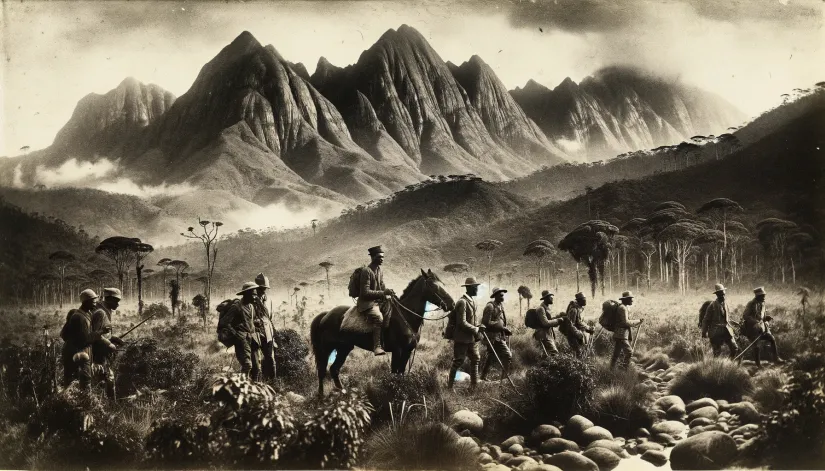
Kenneth Gandar-Dower’s Expedition (1933)
Date: 1933
Location: Aberdare Mountains, Kenya
Participants: Kenneth Gandar-Dower (British explorer) and Raymond Hook.
Two years after Trent’s reported encounter with the Marozi, Kenneth Gandar-Dower (a prominent British sportsman, aviator, explorer, and author) launched an expedition to either capture a live Marozi or obtain more specimens.
However, despite the high expectations, his expedition was only partially successful.
He didn’t manage to kill or capture any of the elusive spotted lions. Still, he did find some circumstantial evidence: three sets of tracks at the same elevation where Trent found his lions (10,000–12,500 feet).
Kenneth believed these tracks were made by a group of Marozi hunting a herd of buffalo, which ruled out the possibility that they were just cubs.
While some adult lions retain their spots, Dower pointed out that they don’t have them as prominently as the pelts he saw.
He also interviewed locals, learning that they distinguish Marozi from both lions and leopards.
In 1937, Gandar-Dower published a book on the subject titled “The Spotted Lion.”
Modern Sightings
Sightings of the Marozi have been extremely rare in the 21st century. So much so that we couldn’t find any verified claims about possible Marozi sightings or encounters over the past 50 years.
So, what happened? Why the sudden stop of all alleged encounters? What could potentially have happened to this cryptid?
We do have some theories and potential explanations below:
Theories and Explanations
Possible Explanations
The mystery of the African spotted lion has led to various theories attempting to explain its existence.
Subspecies Adaptation
One prevalent theory suggests that the Marozi might be a distinct subspecies of lions adapted to montane environments.
This is supported by its unique physical characteristics, such as smaller size and retention of juvenile spots into adulthood, which are unusual for typical savanna lions.
Genetic Mutations
Another hypothesis posits that the Marozi could result from genetic mutations, as lions are known for their genetic diversity, which occasionally results in atypical markings.
Such mutations could explain the persistent spots seen on the Marozi, distinguishing them from other lions.
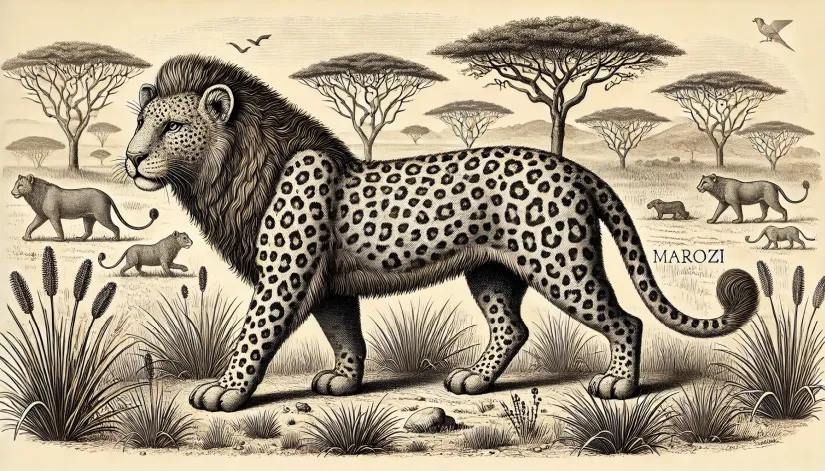
Hybridization
A less likely but intriguing theory is that the Marozi could be a hybrid between a lion and a leopard (known as a leopon).
However, hybridization in the wild is rare due to these two species’ differing habitats and behaviors, making this explanation less probable but still within the realm of possibility.
Undiscovered Species
Lastly, some suggest that the Marozi could be an entirely undiscovered big cat species.
Cryptozoologists like Dr. Bernard Heuvelmans have even proposed scientific names (such as Panthera leo maculatus) for this potential new species.
More Scientific Investigations
Efforts to scientifically verify the existence of the Marozi have been ongoing, though conclusive evidence remains elusive. How so?
First, all the specimens (skins and skulls) collected during some 20th-century expeditions have all been lost. Convenient right? They may have been “misplaced” or so poorly preserved that there’s nothing left to analyze.
Plus, proper analysis of historical specimens requires funding, expertise, and access to advanced laboratory facilities. Securing these resources for a potentially ambiguous case like the Marozi has proven challenging.
Not to mention that the scientific community often views cryptozoological claims with extreme skepticism. And without initial solid evidence, researchers may be reluctant to invest time and resources into studying these specimens.
Even some of those who allegedly encountered the Marozi remained reticent. For instance, W.R. Foran suggested that the spotted lions could simply be a group of Somali lions (Panthera leo somalica) with aberrant markings that migrated into Kenya.
He believed these lions retained their juvenile spots longer than usual due to environmental factors.
Zoologist Charles Albert Walter Guggisberg was also skeptical. In 1963, he stated that the evidence was insufficient to confirm the Marozi as a separate species.
He argued that some East African lions retain their juvenile spots longer than others, and these sightings could simply be of unusually marked lions rather than a new subspecies.
Influence on Local Tourism
If it may not be real, why are Marozi legends still so prevalent in Africa? We believe there is a simple explanation: cryptid tourism.
Stories about the mysterious lion have significantly influenced tourism in the regions where it has been reportedly sighted, particularly in Kenya.
This phenomenon (often referred to as cryptid tourism) draws enthusiasts and curious travelers eager to explore the mysteries of these elusive creatures.
Cryptid Tourism and Economic Impact
So, what exactly is “cryptid tourism?” It involves traveling to locations known for sightings of mysterious and legendary creatures.
In the case of the Marozi, the Aberdare Mountains and surrounding areas in Kenya have become points of interest. This type of tourism attracts cryptozoology enthusiasts and nature lovers who are intrigued by the possibility of encountering rare wildlife.
And the economic impact of cryptid tourism can be substantial.
Visitors contribute to the local economy by spending on lodging, guided tours, local crafts, and other tourism-related services.
This influx of tourists can help diversify the economy and provide funding for infrastructure projects like hospitals, schools, and roads, thereby improving local residents’ living standards.
Comparison with Other African Cryptids
Marozi are not the only African cryptids. In fact, some others share intriguing similarities with the Marozi:
- Nandi Bear: The Nandi Bear is a cryptid reported from East Africa. It is often described as a large, carnivorous animal resembling a hyena or bear. While not a feline, it shares the characteristics of being a large, mysterious mammal from Africa.
- Kasai Rex: This cryptid is described as a giant, predatory reptile allegedly sighted in the Kasai Valley. Though not a mammal, the Kasai Rex shares the Marozi’s association with Africa and the mystery surrounding its sightings.
- Agogwe: The Agogwe is a small, human-like creature reported in East Africa. While it is more often described as a humanoid, it shares the Marozi’s cryptid status in the same geographical region.
- Koolakamba: This cryptid (some believe it roams in Central Africa) is described as a possible hybrid between chimpanzees and gorillas. While primarily an ape, it shares the Marozi’s status as one of the many African mammal cryptids.
Frequently Asked Questions
What is the Marozi?
The Marozi, also known as the spotted lion, is a cryptid believed to be a type of lion with leopard-like spots. It has been reported in Kenya and is characterized by its unusual coat and smaller size than typical lions.
What is the name of the spotted lion?
The spotted lion is commonly referred to as the Marozi.
Where has the Marozi been sighted?
The Marozi has been sighted primarily in the Aberdare Mountains and surrounding regions in Kenya.
How is the Marozi different from other lions?
The Marozi is smaller than typical lions, lacks a mane, and retains leopard-like spots into adulthood, which normal lions lose as they mature.
Have there been any recent sightings of the Marozi?
Based on our own research, recent sightings of the Marozi are extremely rare and largely unverified.
Why do some people believe the Marozi is a myth?
Some believe the Marozi is a myth due to the lack of concrete evidence, possible misidentifications of known animals, and the skepticism of scientific investigations that have not confirmed its existence.

